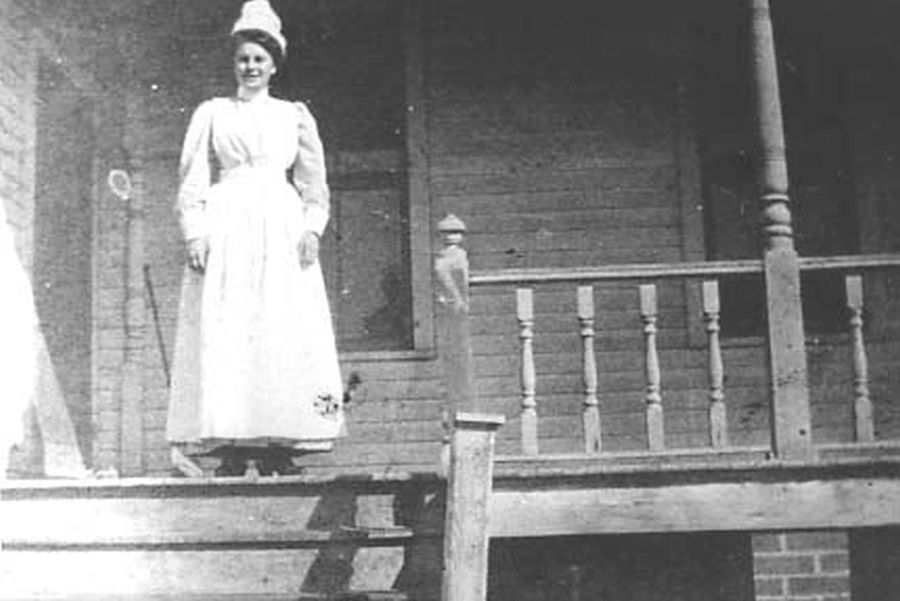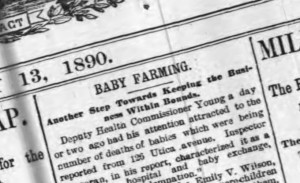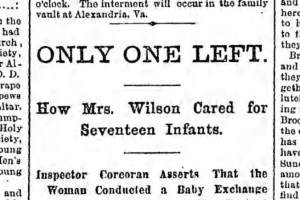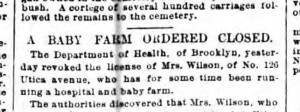THE BABY FARM OF UTICA AVENUE (1890)

Brownstone Detectives investigates the history of our clients’ homes.
The story you are about to read was composed from research conducted in the course of one of those investigations.
Do you know the history of YOUR house?
********************************************************************************************************************************
The red flags began to go up slowly – one by one – as babies began to die.
After Annie Smith, 1 month and 14 days old, it was wee Cora Tanner, just 7 days old. With two infant deaths being reported within the same month from a private residence at 126 Utica Avenue, Inspector Corcoran of the Department of Health was detailed to look into the matter.
THE INSPECTION
Arriving at 126 Utica Avenue, Inspector Corcoran discovered a “two story frame structure in which are available for maternity and nursery purposes four small rooms and an attic apartment.”

Tending this facility, according to the Brooklyn Standard Union, was a Mrs. Emily V. Wilson, her daughter, and a nurse. Onsite, though, was also one baby and five women “patients.”
Corcoran asked Mrs. Wilson to show her license, upon which request “she produced two documents given her by the Department of Health.” The first, dated 12 September 1886, granted permission to board four children at 100 Utica avenue, while the other bearing the date of 18 June 1888, permitted her to keep six children at 795 Herkimer street. She had no license for 126 Utica Avenue.
At this point the inspector asked to view the house’s register, “which the law requires of nursery keepers.” Corcoran, upon review of the record, found it to be “a very peculiar instrument, and anything but what it should be.” One entry, which the Brooklyn Daily Eagle of 13 May noted would “serve as a sample of the others,” read “Jew boy Moses, taken in March 14, adopted next day.” Seventeen babies had been received at the institution so far during the year, but “none of them was kept very long, adopted usually within a few days.”
It was clear to Inspector Corcoran, that Mrs. Wilson’s home was no nursery.
NURSERY OR BABY EXCHANGE?
Legitimate maternity “hospitals” and nurseries were routinely kept in private residences during the 19th century, with oversight, including permitting, provided by the Department of Health. While nurseries have changed little over the years, the maternity hospital of the period was primarily used to house women who were near to childbirth or for those who had recently given birth to a child.

“Baby farms,” on the other hand, which were usually run under the guise of “nurseries” in order to trade in the “sale” of babies, were continuously in the news as the demand for this business was always high and the rewards rather generous. They also made great stories.
For purveyors of these “mills,” their “maternity hospitals” were a sort of amalgam of the two and the perfect setting for poorer women who wanted to give birth to a child, but had no desire to take it home with them. They allowed these women to give birth to and get rid of their children in one place, while offering the baby mill operator the opportunity to engage in a fruitful operation providing babies to couples for a handsome price.
Getting caught, though, running such a “baby farm,” was just as dear, since “the extreme penalty for violation of 288 of the Penal Code,” according to the Brooklyn Daily Eagle, was “one year in the penitentiary and a $500 fine.”
Apparently, there were many operators who were willing to risk getting caught, and many others with political connections who were willing to pay for the “protection” in this particular trade.
THE RESULT OF THE INSPECTION
Inspector Corcoran, in filing his report, noted that the house is admirably situated for a nursery, but evidently has not been used for that purpose.
“It is a regular baby exchange or transfer office,” he stated. “People who want to get rid of children taken them there.”

Corcoran further noted that Mrs. Wilson had no permit to keep either a nursery or a maternity hospital in her present place and “as either, it merits only condemnation.” Furthermore, the register contained “no record of parents or foster parents. In giving dates of births and deaths the record is usually faulty.”
While Wilson’s permits were revoked, the case appeared to become somewhat of a political hot potato, due to Mrs. Wilson’s claimed customers – “the daughters of a minister, a lawyer and a banker had been among the patients treated,” according to Mrs. Wilson.
“Last week,” Mrs. Wilson added, “a woman who adopted a child signed over $10,000 to the infant.”
Soon, the case, which had been reported by the Brooklyn Daily Eagle, The Brooklyn Standard Union, and the New York Herald, dropped completely from the newspapers. Mrs. Wilson likely changed locations – and names – and continued to exchange babies elsewhere.
Undeniably, there was good money to made in the baby business.
———————————————————————————————————————–
 Brownstone Detectives is an historic property research agency. Our mission is to document and save the histories of our clients’ homes. From our research, we produce our celebrated House History Books and House History Reports. Contact us today to begin discovering the history of your home.
Brownstone Detectives is an historic property research agency. Our mission is to document and save the histories of our clients’ homes. From our research, we produce our celebrated House History Books and House History Reports. Contact us today to begin discovering the history of your home.